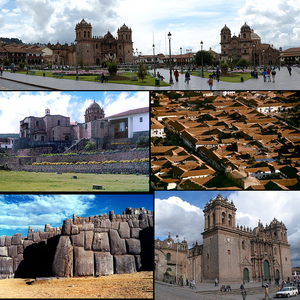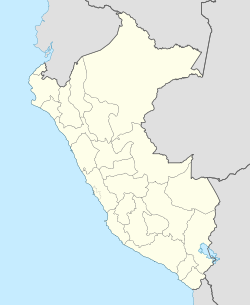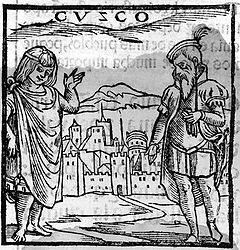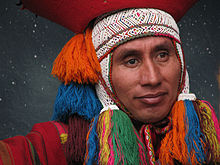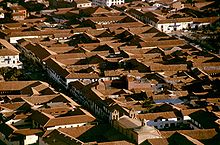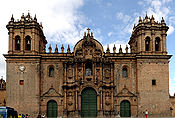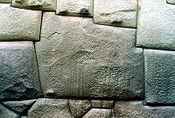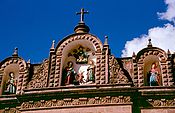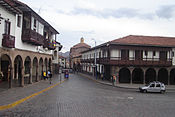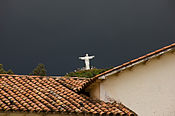- Cusco
-
Cusco Cusco / Cuzco (Spanish)
Qusqu (Quechua)Top: Plaza de Armas, Middle left: Temple of Coricancha, Middle right: Aerial view of Cusco, Bottom left: Sacsayhuamán, Bottom right: Cathedral of Cusco 
Flag
SealNickname(s): La Ciudad Imperial (The Imperial City) Districts of CuzcoDistricts of CuzcoDistricts of Cuzco Coordinates: 13°31′30″S 71°58′20″W / 13.525°S 71.97222°WCoordinates: 13°31′30″S 71°58′20″W / 13.525°S 71.97222°W Country  Peru
PeruRegion Cusco Province Cusco Founded 1100 A.D. 1st Government – Type City – Mayor Luis Florez Area – Total 70,015.3 km2 (27,033 sq mi) Elevation 3,399 m (11,152 ft) Population 2007 – Total 358,935 Time zone PET (UTC-5) – Summer (DST) PET (UTC-5) Area code(s) 84 Website www.municusco.gob.pe Official name: City of Cuzco Type: Cultural Criteria: iii, iv Designated: 1983 (7th session) Reference #: 273 State Party:  Peru
PeruRegion: Latin America and the Caribbean Cusco (
 /ˈkuːzkoʊ/), often spelled Cuzco (Spanish: Cuzco, IPA: [ˈkuθko] or [ˈkusko]; Quechua: Qusqu or Qosqo, IPA: [ˈqɔsqɔ]), is a city in southeastern Peru, near the Urubamba Valley of the Andes mountain range. It is the capital of the Cusco Region as well as the Cuzco Province. In 2007, the city had a population of 358,935 which was triple the figure of 20 years ago. Located on the eastern end of the Knot of Cuzco, its elevation is around 3,400 m (11,200 ft).
/ˈkuːzkoʊ/), often spelled Cuzco (Spanish: Cuzco, IPA: [ˈkuθko] or [ˈkusko]; Quechua: Qusqu or Qosqo, IPA: [ˈqɔsqɔ]), is a city in southeastern Peru, near the Urubamba Valley of the Andes mountain range. It is the capital of the Cusco Region as well as the Cuzco Province. In 2007, the city had a population of 358,935 which was triple the figure of 20 years ago. Located on the eastern end of the Knot of Cuzco, its elevation is around 3,400 m (11,200 ft).Cusco was the site of the historic capital of the Inca Empire and was declared a World Heritage Site in 1983 by UNESCO. It is a major tourist destination and receives almost 2 million visitors a year. It is designated as the Historical Capital of Peru by the Constitution of Peru.[1]
Contents
Spelling and etymology
The aboriginal name of this city was Qusqu. Although it was used in Quechua, its origin has been found in the Aymara language. The word itself originated in the phrase qusqu wanka ('Rock of the owl'), attending to the foundational myth of the Ayar Siblings. According to this legend, Ayar Auca (Ayar Awqa) got wings and flew to the site of the future city and transformed into a rock to mark the possession of the land by his ayllu ('linage').[2]
"¡Go fly over there (they say his wings were born), and by sitting down there take possession in the very seat where that milestone appears, because we'll then settle and live there". Ayar Auca, after hearing the words of his brother, rose on his wings and went to that place Manco Cápac commanded him, he sat there and turned himself into stone and became a possession mark, which in the ancient language of this valley is called cozco, therefore this place remained with the name of Cozco until today.—Juan Diez de Betanzos, Suma y narración de los incas.The Spanish conquistadors adopted the local name, transliterating it into Spanish as Cuzco or less often Cozco. Cuzco was the standard spelling on official documents and chronicles at the colonial epoch.[3] In 1976, the City Mayor of Cuzco signed an ordinance banning the traditional spelling and ordering the use of a new one, Cusco, in the municipality publications. Nineteen years later, in 23 June 1990, the local authorities officialized a brand new spelling instead: Qosqo.
In English, both s[4][5] and z[6][7] are accepted, as there is no international "official" spelling.[8] The Encyclopædia Britannica uses "Cuzco".
History
Killke culture
The Killke occupied the region from 900 to 1200, prior to the arrival of the Incas in the 13th century. Carbon-14 dating of Sacsayhuaman, the walled complex outside Cusco, has demonstrated that the Killke culture constructed the fortress about 1100. The Inca later expanded and occupied the complex in the 13th century and after. On 13 March 2008, archaeologists discovered the ruins of an ancient temple, roadway and acqueduct system at Sacsayhuaman.[9] This find plus the results of excavations in 2007, when another temple was found at the edge of the fortress, indicates religious as well as military use of the facility.[10]
Inca history
Cuzco was the capital of the Inca Empire (13th century-1532). Many believe that the city was planned as an effigy in the shape of a puma, a sacred animal.[11] Under the Inca, the city had two sectors: the urin and hanan. Each was further divided to encompass two of the four provinces, Chinchasuyu (NW), Antisuyu (NE), Qontisuyu (SW) and Qullasuyu (SE). A road led from each of these quarters to the corresponding quarter of the empire. Each local leader was required to build a house in the city and live part of the year in Cuzco, but only in the quarter that corresponded to the quarter of the empire in which he had territory. After the rule of Pachacuti, when an Inca died, his title went to one son and his property was given to a corporation controlled by his other relatives (the process was called split inheritance). Each title holder had to build a new house and add new lands to the empire, in order to own the land his family needed to maintain after his death.
According to Inca legend, the city was built by Sapa Inca Pachacuti, the man who transformed the Kingdom of Cuzco from a sleepy city-state into the vast empire of Tahuantinsuyu. Archaeological evidence, however, points to a slower, more organic growth of the city beginning before Pachacuti. The city was constructed according to a definite plan, and two rivers were channeled around the city. Archaeologists such as Larry Coben have suggested the city plan was replicated at other sites throughout the empire.
The city fell to the sphere of Huáscar in the division of the empire after the death of Huayna Capac in 1527. It was captured by the generals of Atahualpa in April 1532 in the Battle of Quipaipan. Nineteen months later, Spanish explorers invaded the city (see battle of Cuzco).
It is unknown how Cuzco was built, or how its stones were quarried.
Cusco after the Spanish invasion
The first Spaniards arrived in the city on 15 November 1533. Francisco Pizarro officially arrived in Cuzco on 23 March 1534, renaming it the "Very noble and great city of Cuzco". The many buildings constructed after the Hispanic invasion have a mixture of Spanish influence with Inca indigenous architecture, including the Santa Clara and San Blas neighborhoods. The Spanish destroyed many Inca buildings, temples and palaces. They used the remaining walls as bases for the construction of a new city.
The city was retaken from the Spanish during the Siege of Cuzco of 1536 by Manco Inca Yupanqui, a leader of the Sapa Inca. Although the siege lasted ten months, it was ultimately unsuccessful. Manco's forces were able to reclaim the city for only a few days. Throughout the conflict and years of the Spanish colonization of the Americas many of Inca citizens and warriors succumbed to smallpox and died.
Cuzco stands on layers of cultures, with the Tawantinsuyu (old Inca Empire) built on Killke structures, and the Spanish having replaced indigenous temples with Catholic churches, and palaces with mansions for the invaders.
Cuzco was the center for the Spanish colonization and spread of Christianity in the Andean world. It became very prosperous thanks to agriculture, cattle raising, and mining, as well as its trade with Spain. The Spanish colonists constructed many churches and convents, as well as a cathedral, university and Archbishopric. Just as the Inca built on top of Killke structures, Spanish buildings were based on the massive stone walls built by the Inca.
A major earthquake on 21 May 1950 caused severe localised damage in Cuzco. The Dominican Priory and Church of Santo Domingo, which were built on top of the impressive Qoricancha (Temple of the Sun), were among the colonial era buildings affected. The city's Inca architecture, however, withstood the earthquake. Many of the old Inca walls were at first thought to have been lost after the earthquake, but the granite retaining walls of the Qoricancha were exposed, as well as those of other ancient structures throughout the city. Restoration work at the Santo Domingo complex was conducted in such a way as to expose the Inca masonry formerly obscured by the super-structure without compromising the integrity of the colonial heritage.[12] Cuzco had also been the center of a major earthquake in 1650, and many of the buildings damaged in 1950 had been impacted by an earthquake only nine years previously.[13]
Republican era
After Peru declared its independence in 1821, Cuzco maintained its importance within the administrative structure of the country. Upon independence, the government created the Department of Cuzco, maintaining authority over territory extending to the Brazilian border. Cuzco was made capital of the department; subsequently it became the most important city in the south-eastern Andean region.
At the beginning of the 20th century, the city's urban sprawl spread to the neighboring districts of Santiago and Wanchaq.
In 1911, explorer Hiram Bingham used the city as a base for the expedition in which he rediscovered the ruins of Machu Picchu.
Honors
- In 1933, the Congress of Americanists met in La Plata, Argentina and declared the city as the Archeological Capital of the Americas.
- In 1978, the 7th Convention of Mayors of Great World Cities met in Milan, Italy and declared Cusco a Cultural Heritage of the World.
- In 1983, UNESCO, in Paris, France declared the city a World Heritage Site. The Peruvian government declared it the Tourism Capital of Peru and Cultural Heritage of the Nation.
- In 2007, the New7Wonders Foundation designated Machu Picchu one of the New Seven Wonders of the World, following a worldwide poll.[14]
Present
A 1950 earthquake shook the city, causing the destruction of more than one third of the city's structures. Later, the city began to establish itself as a focal point for tourism and began to receive a greater number of tourists.
Since the 1990s, tourism has increased. Currently, Cusco is the most important tourist destination in Peru. Under the administration of mayor Daniel Estrada Pérez, a staunch supporter of the Academia Mayor de la Lengua Quechua, between 1983 and 1995 the Quechua name Qosqo was officially adopted for the city.
Geography
The city of Cuzco extends throughout the Huatanay river valley. Located on the eastern end of the Knot of Cuzco, its elevation is around 3,300 m (10,800 ft). North to Cuzco is the range of Cordillera Vilcabamba with 4–6000 m high mountains. The highest peak is Nevado Salcantay (6271 m) about 60 km (37.28 mi) northwest of Cuzco.[15]
Climate
Cusco has a subtropical highland climate (Köppen Cwb). Its climate is generally dry and temperate, with two defined seasons. The dry season lasts from April through October, with abundant sunshine, and occasional nighttime freezes: July is the coolest month with an average of 9.6 °C (49.3 °F). The wet season lasts from November to March, with night frost less common: November averages 13.4 °C (56.1 °F). Although frost and hail are common, snow is virtually unheard of. The only-one snowfall was recorded in June 1911.
Cusco was found in 2006 to be the spot on Earth with the highest ultraviolet light level.[16]
Climate data for Cuzco Month Jan Feb Mar Apr May Jun Jul Aug Sep Oct Nov Dec Year Record high °C (°F) 28
(82)27
(81)26
(79)26
(79)26
(79)25
(77)25
(77)25
(77)27
(81)29
(84)28
(82)27
(81)29
(84)Average high °C (°F) 18.9
(66.0)18.8
(65.8)19.1
(66.4)19.7
(67.5)19.8
(67.6)19.5
(67.1)19.1
(66.4)19.8
(67.6)19.8
(67.6)20.9
(69.6)20.7
(69.3)19.4
(66.9)19.6 Average low °C (°F) 6.6
(43.9)6.5
(43.7)6.2
(43.2)4.9
(40.8)2.5
(36.5)0.3
(32.5)0.1
(32.2)1.6
(34.9)3.9
(39.0)5.5
(41.9)6.1
(43.0)6.4
(43.5)4.2 Record low °C (°F) 3
(37)2
(36)2
(36)−4
(25)−4
(25)−5
(23)−9
(16)−5
(23)−1
(30)−1
(30)1
(34)1
(34)−9
(16)Precipitation mm (inches) 145.3
(5.72)133.7
(5.264)107.0
(4.213)43.2
(1.701)8.7
(0.343)1.5
(0.059)4.0
(0.157)8.6
(0.339)21.8
(0.858)39.4
(1.551)71.9
(2.831)122.7
(4.831)707.8
(27.866)Avg. precipitation days 18 13 11 8 3 2 2 2 7 8 12 16 102 Source no. 1: World Meteorological Organisation (UN)[17] Source no. 2: BBC Weather[18] Main sights
Although the original Inca city was said to have been founded in the 11th century, more recently scholars have established that Inca did not occupy the area until after 1200 AD. Before them the indigenous people of the Killke culture built the walled complex of Sacsayhuaman about 1100 AD. In November 2008, archeological researchers found that the Killke also built a major temple near Sacsayhuaman, as well as an acqueduct and roadway connecting prehistoric structures.
The Spanish explorer Pizarro sacked much of the Inca city in 1535. Remains of the palace of the Incas, the Temple of the Sun, and the Temple of the Virgins of the Sun still stand. In addition, Inca buildings and foundations in some cases have proved to be stronger than the foundations built in present-day Peru. Among the most noteworthy Spanish colonial buildings of the city is the Cathedral of Santo Domingo, Cusco.
The major nearby Inca sites are Pachacuti's presumed winter home, Machu Picchu, which can be reached on foot by an Inca trail or by train; and the "fortress" at Ollantaytambo. Sacsayhuaman was expanded by the Inca.
Less-visited ruins include: Inca Wasi, the highest of all Inca sites at 3,980 m (13,060 ft); Old Vilcabamba the capital of the Inca after the capture of Cuzco; the sculpture garden at Chulquipalta (aka Chuquipalta, Ñusta España, The White Rock, Yurak Rumi); Tipón with working water channels in wide terraces; as well as Huillca Raccay, Patallacta, Choquequirao, Moray and many others.
The surrounding area, located in the Huatanay Valley, is strong in gold mining and agriculture, including corn, barley, quinoa, tea and coffee.
Thanks to remodelling, Cusco's main stadium Estadio Garcilaso de la Vega attracted more tourists during South America's continental soccer championship, the Copa América 2004 held in Peru. The stadium is home to one of the country's most successful soccer clubs, Cienciano. Cuzco's local team has built a reputation in the world of club soccer, as it has won several international competitions in South America. It has yet to achieve such success in its home country.
The city is served by Alejandro Velasco Astete International Airport.
Architectural heritage
Because of its antiquity and importance, the center of the city retains many buildings, plazas and streets of pre-Columbian times and colonial buildings, which led to his being declared a World Heritage Site by UNESCO in 1983. Among the main sights of the city are:
Barrio de San Blas
This neighborhood housing artisans, workshops and craft shops, is one of the most picturesque sites in the city. Its streets are steep and narrow with old houses built by the Spanish over important Inca foundations. It has an attractive square and the oldest parish church in Cuzco, built in 1563, which has a carved wooden pulpit considered the epitome of Colonial era woodwork in Cuzco.
The Quechua name of this neighborhood is Toq'ocachi which means the opening of the Salt
Calle Hatun Rumiyuq
This street is the most visited by tourists. On the street Hatun Rumiyoq ("Of the Old Rock") was the palace of Inca Roca, which was converted to the Archbishop's residence.
Along this street that runs from the Plaza de Armas to the Barrio de San Blas, one can see the Stone of Twelve Angles, which is viewed as marvel of ancient stonework and has become emblematic of the city's history.
Convent and Church of la Merced
Its foundation dates from 1536. The first complex was destroyed by the earthquake of 1650 and the rebuilding of the church and convent was completed in 1675.
Its cloisters of Baroque Renaissance style, choir stalls, colonial paintings and wood carvings are highlights of a visit to this church, now a popular museum and tourist attraction.
Also on view is an elaborate monstrance made of gold and gemstones which weighs 22 kilos and is 130 cm (51.18 in) in height.
Cathedral
The first cathedral built in Cuzco is the Iglesia del Triunfo, built in 1539 on the foundations of the Palace of Viracocha Inca. Today, this church is an auxiliary chapel of the Cathedral.
The main basilica cathedral of the city was built between 1560 and 1664. Stone was used as the main material, which was extracted from nearby quarries, although some blocks of red granite were taken from the fortress of Sacsayhuamán.
This great cathedral presents late-Gothic, Baroque and plateresque interiors and has one of the most outstanding examples of colonial goldwork. Its carved wooden altars are also important.
The city developed a distinctive style of painting known as the "Cuzco School", and the cathedral houses a major collection of local artists of the time. The cathedral is known for a Cuzco School painting of the Last Supper depicting Jesus and the twelve apostles feasting on guinea pig, a traditional Andean delicacy.
The cathedral is the seat of the Archdiocese of Cuzco.
Plaza de Armas
Known as the "Square of the warrior" in the Inca era, this plaza has been the scene of several important events in the history of this city, such as the proclamation by Francisco Pizarro in the conquest of Cuzco.
Similarly, the Plaza de Armas was the scene of the death of Túpac Amaru II, considered the indigenous leader of the resistance.
The Spanish built stone arcades around the plaza which endure to this day. The main cathedral and the Church of La Compañía both open directly onto the plaza.
Church of la Compañía
This church, whose construction was initiated by the Jesuits in 1576 on the foundations of the Amarucancha or the palace of the Inca Huayna Capac, is considered one of the best examples of colonial baroque style on the American continents.
Its façade is carved in stone and its main altar is made of carved wood covered with gold leaf. It was built over an underground chapel.
This church has a valuable collection of colonial paintings of the Cusco School.
Coricancha and Convent of Santo Domingo
The Coricancha (Quri Kancha) was the most important sanctuary dedicated to the Sun god Inti at the time of the Inca Empire. This temple was named the site of gold because all its walls were covered with gold leaf by the Incas.
With this structure as a foundation, colonists built the Convent of Santo Domingo, in the Renaissance style. The building, with one baroque tower, exceeds the height of many other buildings in this city.
Inside is a large collection of paintings from the Cuzco School.
Historical populations Year Pop. ±% 1614 5,000 — 1761 6,600 +32.0% 1812 6,900 +4.5% 1820 9,000 +30.4% 1827 15,000 +66.7% 1850 16,000 +6.7% 1861 15,000 −6.3% 1877 17,000 +13.3% 1890 18,900 +11.2% 1896 20,000 +5.8% 1900 25,000 +25.0% 1908 33,900 +35.6% 1920 30,500 −10.0% 1925 32,000 +4.9% 1927 33,000 +3.1% 1931 35,900 +8.8% 1940 40,600 +13.1% 1945 45,600 +12.3% 1951 50,000 +9.6% 1953 54,000 +8.0% 1961 80,100 +48.3% 1969 115,300 +43.9% 1981 180,227 +56.3% 1993 250,270 +38.9% 1997 275,318 +10.0% 2000 295,530 +7.3% 2005 320,900 +8.6% 2006 338,965 +5.6% 2007 390,000 +15.1% 2008 463,000 +18.7% 2009 510,000 +10.2% Population
Until the late 18th century Cusco was the most populous city in the continent, even more than Lima. But because of the great revolution of Túpac Amaru II in 1780, the white population migrated to Arequipa, considered safer from a possible new uprising. So, until the 20th century, the population was largely mestizo and indigenous, but now the white population has grown significantly in the city as high as 30%, as it is experiencing a demographic explosion process led by the tourism boom.
The city has a population of 390,000 people by 2008 according to INEI.
Population by district City district Extension
km²Population
2007 census(hab)Housing
(2007)Density
(hab/km²)Elevation
mslCuzco 116.22 km² 108,798* 28,476 936.1 3,399 msl San Jerónimo 103.34 km² 28,856* 8,942 279.2 3,244 msl San Sebastian 89.44 km² 85,472* 18,109 955.6 3,244 msl Santiago 69.72 km² 66,277* 21,168 950.6 3,400 msl Wanchaq 6.38 km² 54,524* 14,690 8,546.1 3,366 msl Total 385.1 km² 358,052* 91,385 929.76 — *Census data conducted by INEI[19] Food
As headquarters to the Inca Empire, Cuzco was an important agricultural region. It was a natural reserve for thousands of native Peruvian species, including around 2,000 varieties of potato cultivated by the people.[20] Recently many fusion and neo-Andean restaurants have developed in Cuzco, in which the cuisine is prepared with modern techniques and incorporates a blend of traditional Andean and international ingredients.[21] Also, a cacao and chocolate museum, ChocoMuseo, recently opened in the center of the city. The purpose of this place is to teach people about Peruvian cacao and also the whole process to make artisanal chocolate. .
Industry
International relations
See also: List of twin towns and sister cities in PeruTwin towns—Sister cities
 Copán, Honduras
Copán, Honduras Xi'an, China
Xi'an, China Potosí, Bolivia
Potosí, Bolivia Cuenca, Ecuador
Cuenca, Ecuador Rio de Janeiro, Brazil
Rio de Janeiro, Brazil Madison, Wisconsin, United States
Madison, Wisconsin, United States Jerusalem, Israel
Jerusalem, Israel
Partnerships
Gallery
In modern culture
- In the children's movie The Emperor's New Groove and its spin-off animated television series The Emperor's New School, the main protagonist is "Kuzco", the young, often immature fictional emperor of the Incas.
- "Cuzco" was the name of a song on E.S. Posthumus' 2001 album Unearthed. Each song on the album was named after an ancient city.
- The Anthony Horowitz novel Evil Star takes places partly in Cusco.
- Cuzco is the city where the legendary radio presenter John Peel died whilst on a working holiday.
See also
- Inca road system
- Governorate of New Castile
- Cusco School
- Iperu, tourist information and assistance
- Tourism in Peru
- List of archaeoastronomical sites sorted by country
- PeruRail
- Pambokancha, Inca religious site
References
- Notes
- ^ "Constitución del Perъ de 1993". Pdba.georgetown.edu. http://pdba.georgetown.edu/Constitutions/Peru/per93reforms05.html#titIIcapI. Retrieved 22 July 2009.
- ^ Cerrón-Palomino, Rodolfo (2007). "Cuzco: La piedra donde se posó la lechuza. Historia de un nombre.". Andina (Lima) 44: 143–174. ISBN 0259-9600.
- ^ Carrión Ordóñez, Enrique (1993). "Cuzco, con Z". Histórica (Lima) XVII: 267–270.
- ^ [1][dead link]
- ^ [2][dead link]
- ^ "City of Cusco – UNESCO World Heritage Centre". Whc.unesco.org. 21 August 2007. http://whc.unesco.org/en/list/273. Retrieved 22 July 2009.
- ^ "Cusco Travel Information and Travel Guide – Peru". Lonely Planet. http://www.lonelyplanet.com/worldguide/peru/cusco/. Retrieved 22 July 2009.
- ^ of words in English
- ^ Kelly Hearn, "Ancient Temple Discovered Among Inca Ruins", National Geographic News, 31 March 2008, accessed 12 January 2010
- ^ "NEWS - Comcast.net". Comcast.net<!. http://www.comcast.net/news/index.jsp?cat=GENERAL&fn=/2008/03/14/911994.html&cookieattempt=1. Retrieved 22 July 2009.
- ^ "The history of Cusco". cusco.net<!. http://www.cusco.net/articulos/cuscoinca.htm#Puma. Retrieved 25 July 2009.
- ^ "Koricancha Temple and Santo Domingo Convent – Cusco, Peru". Sacred-destinations.com. http://www.sacred-destinations.com/peru/cusco-koricancha.htm. Retrieved 15 September 2011.
- ^ "The Cusco, Peru, Earthquake of May 21, 1950 – ERICKSEN et al. 44 (2): 97 – Bulletin of the Seismological Society of America". Bssa.geoscienceworld.org. http://bssa.geoscienceworld.org/cgi/content/abstract/44/2A/97. Retrieved 15 September 2011.
- ^ Reuters via ABC News Australia "Opera House snubbed as new Wonders unveiled" 7 July 2007
- ^ Andes map
- ^ Liley, J. Ben and McKenzie, Richard L. (April 2006) "Where on Earth has the highest UV?" UV Radiation and its Effects: an update NIWA Science, Hamilton, NZ;
- ^ "World Weather Information Service – Cuzco". UN. http://worldweather.wmo.int/029/c00110.htm. Retrieved 3 May 2010.
- ^ "Average Conditions Cusco, Peru". BBC Weather. http://www.bbc.co.uk/weather/world/city_guides/results.shtml?tt=TT001930. Retrieved March 2010.
- ^ Censo 2005 INEI
- ^ "Cusco, Peru Bans GM Products To Protect Diversity Of Native Potatoes". Solutions-site.org. http://www.solutions-site.org/artman/publish/article_338.shtml. Retrieved 22 July 2009.
- ^ Guide to Peruvian Food, Cusco Reference
- ^ "Ciudades Hermanas (Sister Cities)" (in Spanish). Municipalidad del Cusco. http://www.municusco.gob.pe/ver.php?id=6. Retrieved 23 September 2009.
- ^ "::Bethlehem Municipality::". bethlehem-city.org. http://www.bethlehem-city.org/Twining.php. Retrieved 10 October 2009.
- ^ "Kraków otwarty na świat". krakow.pl. http://www.krakow.pl/otwarty_na_swiat/?LANG=UK&MENU=l&TYPE=ART&ART_ID=16. Retrieved 19 July 2009.
External links
Cusco travel guide from Wikitravel
- Bibliography about Cuzco (Spanish)
- Government Site (Spanish)
- Government Cultural Site (Spanish)
- http://www.regioncusco.gob.pe/2.0/ Government site about Cusco Region] (Spanish)
- PromPerú: Government Tourism Site on Cusco
- General facts and travel information about Cusco
- General information and basic facts
 Peruvian cities with a population of over 100,000
Peruvian cities with a population of over 100,000World Heritage Sites in Peru 
Chan Chan Archaeological Zone · Chavín Archaeological Site · City of Cuzco · Historic Centre of Lima · Historical Centre of the City of Arequipa · Historic Sanctuary of Machu Picchu · Huascarán National Park · Manú National Park · Lines and Geoglyphs of Nasca and Pampas de Jumana · Rio Abiseo National Park · Sacred City of Caral-Supe
Categories:- Cities in Peru
- World Heritage Sites in Peru
- Populated places in the Cusco Region
- Archaeological sites in Peru
- Cusco
Wikimedia Foundation. 2010.

